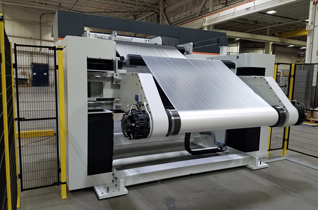

February 12 2019

When web materials are manufactured in a continuous process, winding them into the form of a roll or reel has been recognized as a very efficient method to transport them either to the consumer or to the next step in the manufacturing process. Secondary manufacturing and converting operations, such as printing, extrusion laminating, or slitting and rewinding, start by unwinding material from a roll into the downstream process. Process operating speeds and type of unwind selected can have an impact on the level of safeguarding required to meet current safety standards.
A parent roll of product is most commonly supported in an unwind by its core. This is accomplished by a full width shaft or by short shafts (or chucks) that are inserted into each end. Torque is applied to the shaft or chuck by either a brake or motor to induce the desired amount of tension in the web as it is being pulled by the downstream process. A drawing-in or trapping hazard can exist between the parent roll and the floor or machine member. Nip hazards can also exist between the web and either the rollers that support it or nearby machine members.Automatic unwinds that attach the start of a new roll to the tail of an expiring roll can have in-running nip and knife hazards in addition to the aforementioned hazards. Barrier guards that prevent access to these hazards must be of adequate height and positioned at a distance deemed safe by today's standards. Where barrier guards make routine access for roll loading and unloading cumbersome, sensitive protective equipment in the form of light curtains or laser scanners can be used provided their sensing field is at a safe distance from the hazard. This distance is calculated using a formula that takes machine operating speed and stopping time into account to ensure that when the safety device is triggered, the machine comes to a complete stop before an operator can reach the hazard.
Manufacturers of unwinding equipment must employ a risk assessment process to identify the necessary safeguarding for their machines. Buyers in search of unwinds should be aware of today's safety regulations and ensure that what they're buying meets these standards. Although unwinds may pose less of a risk to operate than the equipment they are feeding web into, in almost every case hazards are present and must be addressed to ensure a safe workplace for your operators.
Incorporating the necessary safeguards to your unwind is an essential requirement to a safe workplace. Please be sure to keep a watch for follow-ups to our machinery safety series where we discuss safety guidelines for other equipment in your converting operation.